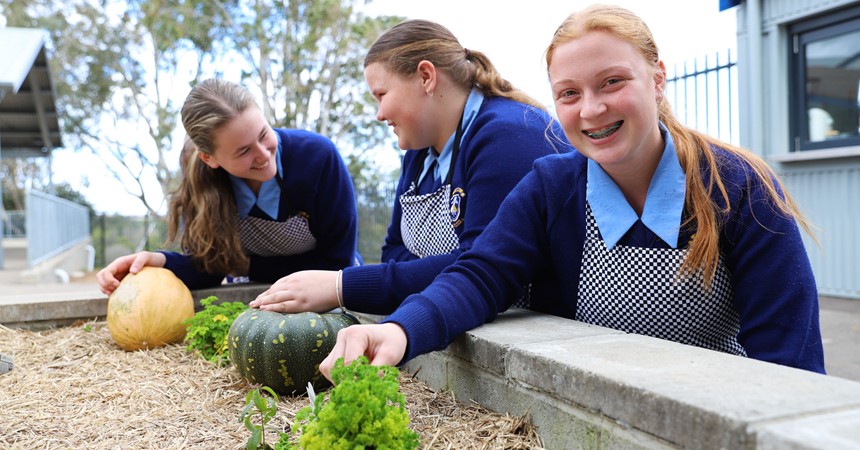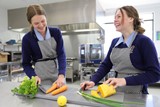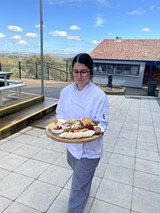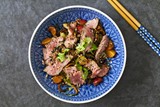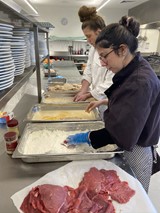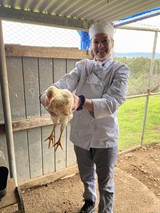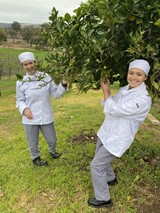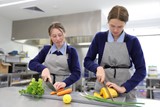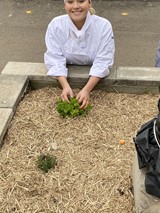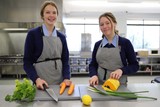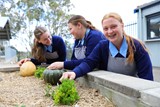The school is situated on picturesque grounds with extensive views of green fields, rich farmlands, cattle grazing, the Hunter River and distant mountains. It’s a uniquely beautiful backdrop providing an ideal opportunity for students to appreciate the environment as they their master Food Technology studies.
The school’s 60-hectare farm, Olive Grove, which is located a short twenty minute drive, provides students with an opportunity to immerse themselves in the production of food, following their products from paddock to plate. School Principal, Robert Holstein, says this experience allows students to develop an understanding of the interactive nature of the land, “and to then build a respect for all living and non-living things”.
The school’s hospitality teacher, Kristy Roach, says the responsible production and consumption of food is a core focus of her lessons, some of which concentrate on food preservation techniques; using seasonal produce (preferably home-grown); substitute ingredients; and, the various applications of ‘food waste’, such as bones and vegetable off-cuts to make broth.
“We share this with the students so they can see how their footprint impacts upon the world they live in and are heading out into on their own in a few years,” she says.
Ms Roach says that this educational approach inspires students to have a greater awareness of the environment, as well as enabling them to consider the financial and nutritional benefits of mindful consumerism.
“We always want our students to be thinking about how they can use natural produce to reduce the cost on their budgets, especially if heading off to university or other study, where income may be restricted but nutrition is still highly important,” she says.
“We have a huge emphasis on nutritional benefits of fresh fruits and vegetables, especially their skin, and look at the nutritional loss of preparation and various cooking methods. We also look at the importance of nutrition in the soil and the impact on the environment if variation production practices were reduced or stopped.”
Students respond well to the lessons, particularly ones that include use of native ingredients they may not have come across at home.
“As acknowledgment to our history we often cook with native ingredients that Aborigines have been using for generations,” Ms Roach says. “It’s been such a success that soon we will be introducing a new garden and yarning circle that will allow us greater access to native ingredients.”
Kangaroo Stir Fry
In line with Stage 4 Curriculum for Technology, students helped develop our kangaroo stir fry recipe, which includes Aboriginal and Asian influences.
Aboriginal people have eaten kangaroo for thousands of years. It is a healthy source of red meat, but it is so lean it can easily become dry and tough if overcooked, or chewy if it is undercooked. For best results, kangaroo should be cooked quickly and using high heat, as this will keep the meat tender and prevent it from drying out. It is best served rare to medium rare, except for mince and sausages.
Ingredients
1 kangaroo steak, thinly sliced
1 tablespoon oil
½ diced onion
1 tsp garlic or 1 clove
1-2 cups shredded red cabbage
1-2 red chillies, thinly sliced
2 cups baby spinach or warrigal greens
1 carrot thinly cut into sticks (julienne)
½ cup corn kernels
1 egg
1 celery stalk
¼ cup crushed macadamia (optional)
½ cup bush tomato relish (or, a pepper berry sauce if preferred)
1 packet rice noodles
Method
- Complete all mise en place (preparation before cooking – cutting vegetables and meat, making the relish if not using a pre-made mix, boiling water for noodles and so on).
- Whisk egg and cook thinly like an omelette. Remove from pan and shred thinly.
- Add noodles to boiling water, as per instructions on the packet.
- Heat oil in pan using medium heat, before adding garlic, onion and chillies. Stir regularly, sautéing until they become lightly golden.
- Turn up the heat to high before adding kangaroo to the pan. Cook till lightly browned on the outside.
- Add into pan carrots, corn, celery, egg, cabbage and spinach or warrigal greens. Gently sauté, allowing some crunch on the vegetables to remain.
- Stir through the relish, chopped parsley and noodles until all are lightly covered. Season with salt and pepper.
- Serve on a plate with a sprig of parsley to garnish.

